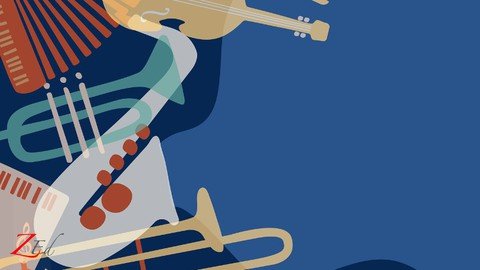
Free Download Instrumental Thinking — Part I
Published 3/2024
MP4 | Video: h264, 1920x1080 | Audio: AAC, 44.1 KHz
Language: English | Size: 1.75 GB | Duration: 2h 52m
Instrumental Presentations and Possibilities
What you'll learn
We handle tools to you how to treat simple lines into instrumental parts for different instrument families.
We deal with each characteristic of each instrument family and experience its implications into varied writing.
We make difference between treatment of a single string instrument and instrument string groups.
This study offers a deeper preparation into the art of orchestration.
Additional information about playing techniques, notation and ranges are incorporated as well.
Requirements
Basic knowledge of music theory is required.
Description
This course is an excellent preliminary study, well suited as a preparation for Dr. . Swerts' Orchestration Course, "The Five Archetypes of Orchestration," Parts I, II, and III-V will follow later. Here, though, with only one single folk song as a model, various instrumental presentations, possibilities, and techniques will be explained and demonstrated, modifying the original model into a new musical context as a consequence of the chosen instrument. In this first part, all the families of the orchestra will be presented and discussed one by one. In the second part, we will proceed with instrumental combinations of the same families, but as duos, trios, and quartets, and various treatments of the string orchestra as well. Moreover, each model will each time rely on the original model of the folksong; as such, you will notice the immense difference in textures due to the choice of different instrument combinations. Some famous examples from the orchestral literature are also applied where necessary and possible. After completing both courses (Instrumental Thinking Parts I and II), you will have a much clearer idea of the characteristics of each instrument type, which will allow you to go deeper into the basic elements of orchestration, as illustrated much more in Dr. Swerts course mentioned above. There, we go deeper into the different textures, where many combinations will be explained via the canon of Western orchestral literature and with assignments and worksheets.
Overview
Section 1: Introduction
Lecture 1 Introduction
Lecture 2 Commentaries upon the Folksong 'There sat a snow-white bird'
Section 2: The Woodwind Instruments
Lecture 3 The Piccolo
Lecture 4 The Flute
Lecture 5 The Alto Flute in G
Lecture 6 The Oboe
Lecture 7 The English Horn
Lecture 8 The Clarinet
Lecture 9 The Bass Clarinet
Lecture 10 The Bassoon
Lecture 11 The Double Bassoon
Section 3: The Brass Instruments
Lecture 12 The Trumpet
Lecture 13 The French Horn
Lecture 14 The Trombone
Lecture 15 The Tuba
Section 4: The Percussion Instruments and the Harp
Lecture 16 Glockenspiel and Tubular Bells
Lecture 17 Vibraphone and Marimba
Lecture 18 Timpani
Lecture 19 The Harp
Section 5: The String Instruments
Lecture 20 Violin and Violin Section
Lecture 21 The Viola and the Viola Section
Lecture 22 The Violoncello and the Cello Section
Lecture 23 The Double Bass and the Double Bass Section
Section 6: Preview Part II
Lecture 24 Part II — Preview
This course is intended both for amateur and professional musicians, music students, performers, composers and conductors. It tend to offer deeper musical insights into the mechanism of composition and music.
Homepage
https://www.udemy.com/course/instrumental-thinking/Rapidgator
vanxf.Instrumental.Thinking..Part.I.part1.rar.html
vanxf.Instrumental.Thinking..Part.I.part2.rar.html
Uploadgig
vanxf.Instrumental.Thinking..Part.I.part1.rar
vanxf.Instrumental.Thinking..Part.I.part2.rar
NitroFlare
vanxf.Instrumental.Thinking..Part.I.part1.rar
vanxf.Instrumental.Thinking..Part.I.part2.rar
Fikper
vanxf.Instrumental.Thinking..Part.I.part1.rar.html
vanxf.Instrumental.Thinking..Part.I.part2.rar.html
